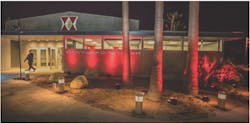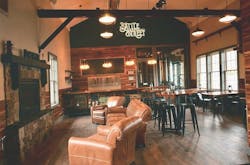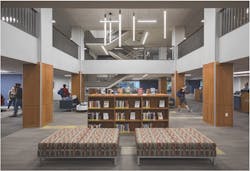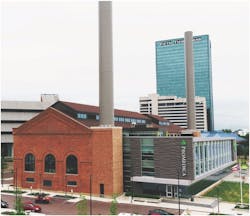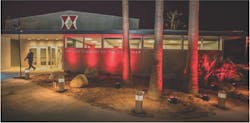2018 Reconstruction Awards: Honorable mentions
By David Barista, Editorial Director
Back on track
Battle Street Brewery
An eyesore train depot becomes a community gem. Photo: Chuck Little Photography.
For more than 30 years, the Dansville-Mount Morris Railroad (D&MM) train depot sat abandoned, slowly rotting, in the heart of this Western New York town of 5,300. The building served as a commercial stop for 90 years for this short-line railroad, which still operates today as part of the Rochester and Southern Railroad.
In 2015, two local brothers purchased the depot building at an auction, and set out to achieve their dream of opening a brewery “to make beer with friends,” one of them told the local newspaper. Their vision turned into an obsession with saving a vital piece of the town’s history.
The restoration project involved stabilizing the existing structure to prevent collapse and preserving as much of the existing depot as possible while designing for a modern, seven-barrel brewing operation. The project team used archived photographs and on-site investigation to recreate important pieces, like the original board and batten siding, that were lost over the years. They rebuilt the station’s roof, but meticulously recreated its original uneven eave lines to maintain the historic charm. Inside, the team reused available elements. Existing sliding doors are now tabletops for the tasting room. The bar footrest is made from old rusted rail tracks. The original ticket booth still stands, and vintage photographs cover the walls throughout.
BUILDING TEAM Acomb Ostendorf and Associates (submitting firm, experience designer) Battle Street Brewery (owner) The Stonybrook Design Studio (architect) Shay Construction (GC) DETAILS 3,750 sf Total cost $850,000 Construction time November 2016 to February 2017 Delivery method Design-build
Millikin's New 'Front Door'
University Commons, Millikin University
An outmoded campus library is a new hub for collaboration. Photo: Sam Fentress/Fentress Photography.
At five stories and 87,000 sf, the University Commons is the largest project in the 117-year history of Millikin University. It is also its most important building.
The project, which involved renovating and expanding the school’s Staley Library, creates, for the first time, a unified home for the university’s Performance Learning program. This educational model, designed to jump-start students’ career preparedness, requires that all students “perform” their knowledge before their peers, professors, and the business community. Students work in small teams on project-based learning initiatives, from launching businesses to creating awareness campaigns. Collaboration is at the heart of learning at Millikin.
This multipurpose facility combines library and student center functions in highly flexible, tech-enabled spaces. Workspaces and meeting areas surround the perimeter of each floor, and feature flexible furniture, integrated technology, and white boards. Collaboration studios support small-group planning, while tech studios and a media arts center provide hands-on learning.
The team utilized the library’s four-story open atrium to streamline circulation (the existing building had a complex network of stairs) and to serve as the hub of the facility. Glass-enclosed meeting rooms were inserted on half levels along the stairway to encourage interaction. Interior glass was used throughout to overcome the hurdle of low, cramped ceilings.
BUILDING TEAM Hastings+Chivetta Architects (submitting firm, architect) Millikin University (owner) IMEG Corp. (SE, MEP) S.M. Wilson (GC) DETAILS 87,000 sf Total cost $24.4 million Construction time November 2015 to August 2017 Delivery method CM at Risk
Toledo Treasure
Promedica Headquarters Steam Plant
A Burnham-designed steam plant gets new life.Photo: Tom Ethington.
Designed by Daniel Burnham in the mid-1890s, the Toledo Edison Water Street Station dutifully served this northern Ohio city for more than eight decades, initially as a power plant, then as a steam plant. In the early 1980s, when advances in HVAC technology made steam heat obsolete, the city closed the plant for good. There the building sat for 30 years, boarded up and decaying—a blight on the banks of the Maumee River.
In June 2003, the steam plant was listed on the National Register of Historic Places. A decade later, local nonprofit healthcare provider ProMedica took on the challenge of restoring the steam plant for use as its new headquarters. The goal: to create a contemporary, four-story office building inside a single-story, structurally delicate shell, with financial assistance via state historic preservation tax credits.
Restoration work involved threading a new structural steel frame throughout the plant while keeping the old red iron support steel in place; rebuilding the slate and clay tile roof; and elevating the building’s first floor above the flood plain of the adjacent river, which called for seven feet of fill to be brought into the existing building.
A three-story addition with floor-to-ceiling windows facing the river completed the headquarters campus, which is designed to accommodate more than 1,000 employees.
BUILDING TEAM Rudolph Libbe Group (submitting firm, CM) ProMedica (owner) HKS Architects (architect, SE) SSOE (MEP) Mannik & Smith Group (CE) Accel Fire Systems (fire protection) DETAILS 123,465 sf Total cost Confidential Construction time October 2015 to August 2017 Delivery method CM at Risk
Armory lives on
Wende Museum of the Cold War
It took a community effort to get this museum built. Courtesy Wende Museum.
The story of the Wende Museum is one of grit and determination on the part of the project team, city leaders, and the community. An adaptive reuse of an abandoned national guard armory, the project involved years of fundraising, donations, and pro bono services to make this non-profit museum a reality. Numerous product manufacturers donated materials and systems (roofing, waterproofing, lighting, HVAC), and all major subcontractors gifted time or materials for the cause.
The team worked closely with the city and local organizations to create a community-centric educational facility. The city granted a 75-year lease for $1 in exchange for a free, fully accessible museum with community-focused programs, exhibits, and events. Meetings with school district officials led to hands-on history and training programs for students, including internship opportunities for high schoolers. The museum houses a 100,000-piece collection of art, archives, and memorabilia—one of the largest Cold War collections in the U.S.
The armory was constructed to survive a first strike of an atomic bomb dropped on Los Angeles. It includes two above-ground bunkers with walls nine inches thick. The building still has the original air filtration system embedded into the walls.
Renovation work included the installation of a space-saving, two-pipe HVAC system; construction of a storage area with custom, 10-foot-tall, 100-foot-long windows that let visitors see into the collection; and the reuse of existing materials, such as the colonnade eve system and nuclear bomb vaults.
BUILDING TEAM Gafcon (submitting firm, CM) Paravent Architects (architect) Montenegro Consultants (SE) Building Solutions Group (MEP, CE) Antonio Acoustics (acoustical engineer) John Levy Lighting Productions (lighting design) Segal Shuart Landscape Architects DETAILS 12,596 sf Total cost $6.5 million Construction time November 2016 to November 2018 Delivery method Design-bid-build
